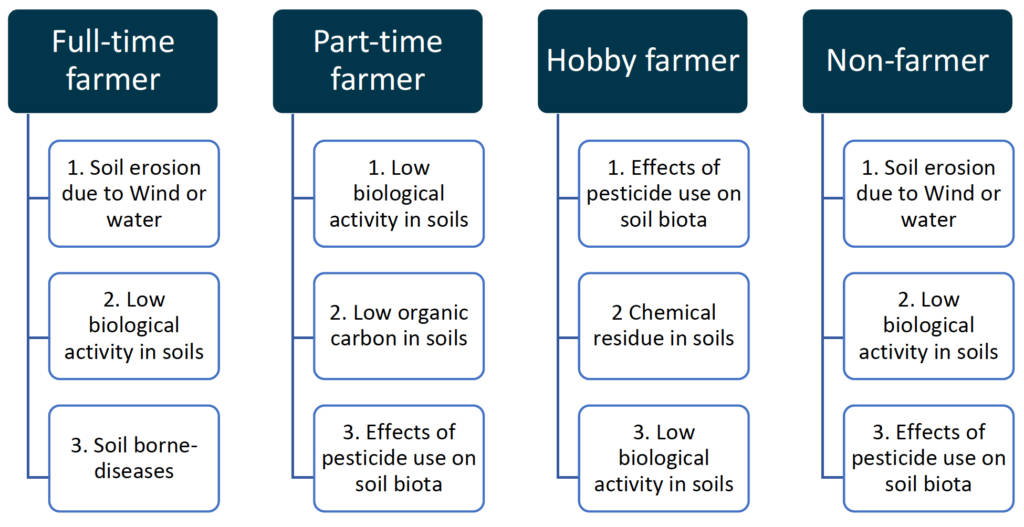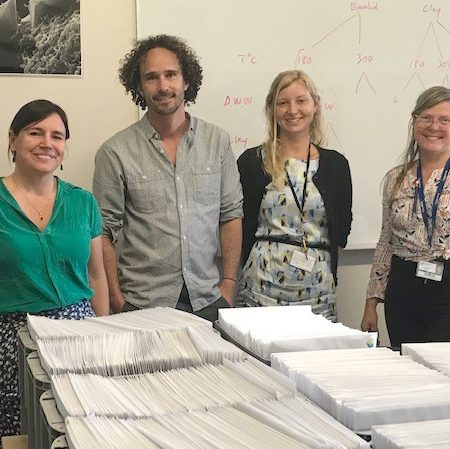Landholders In The Eyre Peninsula
Paper surveys were mailed out to all properties on the Eyre Peninsula over 10ha, with 478 returned surveys resulting a response rate of 29%. The average property ownership of our respondents was two, doubling the spatial coverage of our surveys.
Landholders In The Eyre Peninsula
The most common land use is for cropping (76%), followed by sheep for wool and meat (both 62%). The median land holding was 1500ha, held over two properties within the Eyre Peninsula. 76% of respondents live on their Eyre Peninsula property, with the median length of family ownership being 50 years. Overall, respondents had a median age of 59 years and 90% were male.
Farm Management
In operational terms, 78% of respondents report an income from agriculture on the Eyre Peninsula and of these 63% report a net profit of greater than $50,000 in the financial year 2018/2019. 51% bought additional land in the last 20 years and 16% subdivided or sold part of their property in the same period. Full-time farmers work an average of 53 hours on-property per week and 59% of respondents have another member of the family working on the property. Off-property income is received by 34% of respondents and 23% of their partners, with 43% being greater than $50,000 in the 2018/2019 financial year. 78% had completed secondary school or higher, with 16% holding tertiary qualifications.
Engagement With Industry Groups
43% of respondents were members of an industry group (56% of full-time farmers), and 44% have a property management or whole farm plan (53% of full-time farmers). 73% of respondents had completed a short course/workshop relevant to property management in the past 5 years (22% of partners also had), and 53% had attended field days/farm walks/demonstrations focused on soil health and productivity in the past 12 months.
Farmer Types And Profiles
Farmer types present a useful way to see how different priorities influence landholder management practices. Participants self-identify into one of four groups based on their engagement with farming: 62% of respondents identified as full-time farmers, 14% as part-time farmers, 8% as hobby farmers and 16% as non-farmers. These types often have a lot in common, but there are important and significant differences amongst the groups that will be examined in detail in the full report. There were no significant differences by rainfall zone.
Some important characteristics of each type on the Eyre Peninsula are as follows:
- Full-time farmers represent the majority of respondents (62%), have the highest rate of male respondents (95%) and an average age of 54 years. As a group they have the highest rates of residency, with 91% living on their Eyre Peninsula property. They own the most land, with an average holding of 3709 hectares. They also have the longest family ownership of the property, with the median length sitting at 70 years, and are most likely to have another member of family working on the farm (79%). 78% have secondary school education and higher, including 12% at tertiary level. Their most likely land use is cropping (97%), sheep for wool and meat (both 74%) and pasture (54%).
- The second most common type is the non-farmer (16%). This group has the highest rate of female respondents (27%), has an average age of 62 years and is also the most highly educated group, with 40% of respondents holding tertiary qualifications. Average property size in this group is 939 hectares. The median length of ownership is 20 years, and this 2 group is most likely to use the land as an area of remnant native vegetation, for example trees, grasslands or wetlands (50%). They have the lowest rates of principal residency on their Eyre Peninsula property (41%) and least likely to have another member of the family working on the property (8%).
- Part-time farmers make up 14% of respondents. The average age of this group is 60 years and 90% of respondents were male. Average property-size is the second highest, with an average holding of 1156 hectares. 57% live on the property and the length of family connection is the second highest at a median of 40 years, with 40% reporting that other members of the family also work on the property. The most common land use is for cropping (83%), sheep for wool (64%) and pasture 63%). Similar to full-time farmers, 80% of part-time farmers have completed secondary school and higher and 9% have completed tertiary education, the lowest rates of tertiary completion amongst the four types.
- Hobby farmers make up just 8% of respondents and have the lowest average property size of 186 hectares. They have an average age of 60 years and 82% of respondents were male. This group has a similar level of residency as the part-time farmer group, with 59% living on the property as their principal place of residence. Hobby farmers have the shortest length of ownership or management of the property, with a median length of 15 years, and 37% have another family member working on the farm. This group uses their land for a range of activities, including sheep for meat (53%), pasture (33%) and set aside areas for remnant native vegetation (33%).
With these profiles and relative weightings in mind, it is interesting to consider the similarities and differences in landholder identification of issues at both the regional and property scale:


Access To Information
Across all farmer types, respondents are most likely to seek information and advice on property management from other farmers (89% of full-time farmers and 85% of part-time farmers in particular). This shows a strong reliance on knowledge networks within the Eyre Peninsula and indicates the significant potential of these networks and relationships for knowledge transfer.
Combined with the fact that ‘Field Days’ was the highest ranked mode of receiving information for full-time farmers (71%) and second for part-time farmers (57%), the benefits of combining networking and communication/education activities may be a useful mode of knowledge transfer in the region. The tables on the following page show the aggregated data across all farmer types and it can be seen that besides other farmers, the majority of respondents look to friends/neighbours/relatives, again emphasising the role of networked knowledge. Other knowledge sources for the majority of respondents are the Bureau of Meteorology, independent agricultural advisors, and PIRSA/SARDI. To see the results for EPARF/LEADA in more detail, this table details differences by farmer type:
|
|
Full-time farmer
|
Part-time farmer
|
Hobby farmer
|
Non-farmer
|
|---|---|---|---|---|
|
EPARF
|
36%
|
19%
|
0%
|
3%
|
|
LEADA
|
25%
|
17%
|
0%
|
3%
|
Source Of Knowledge – All Respondents
|
Source
|
Percentage
|
|---|---|
|
Other farmers ###
|
77%
|
|
Friends/neighbours/relatives ###
|
67%
|
|
Bureau of Meteorology ###
|
59%
|
|
Independent agricultural consultants, agronomists or stock agents ### ***
|
55%
|
|
PIRSA/SARDI ###
|
50%
|
|
Commercial agricultural consultants, agronomists or stock agents ###
|
40%
|
|
Local farming groups (e.g. Ag Bureau, Landcare) ### ***
|
35%
|
|
Eyre Peninsula NRM
|
33%
|
|
Rural R&D organisations (e.g. GRDC, MLA, AWI, SANTFA) ###
|
30%
|
|
EPARF ### ***
|
25%
|
|
LEADA### ***
|
19%
|
|
Direct contact with researchers/extension officers ###
|
14%
|
|
Local Council
|
13%
|
|
Commodity groups ###
|
12%
|
|
Environmental organisations, eg. Greening Australia ###
|
8%
|
|
Universities/CSIRO
|
7%
|
|
Soil CRC
|
5%
|
Mode Of Information – All Respondents
|
Source
|
Percentage
|
|---|---|
|
Field days ###
|
56%
|
|
Websites ###
|
54%
|
|
Newspapers ###
|
53%
|
|
Magazines ##
|
49%
|
|
Email ###
|
49%
|
|
Local Radio ###
|
42%
|
|
Brochures/leaflets/newsletters ###
|
37%
|
|
EP Farming Systems Summary ### ***
|
35%
|
|
Television ***
|
34%
|
|
Books
|
25%
|
|
Journals (research papers) ###
|
25%
|
|
National/State radio
|
22%
|
|
Twitter ###
|
17%
|
|
YouTube ###
|
13%
|
|
Facebook
|
10%
|
|
Podcasts
|
6%
|
|
Instagram
|
2%
|
|
Whatsapp or Messenger groups
|
2%
|
Source
N=460-462
### Significant difference Farmer Type
*** Significant difference Rainfall Zone

